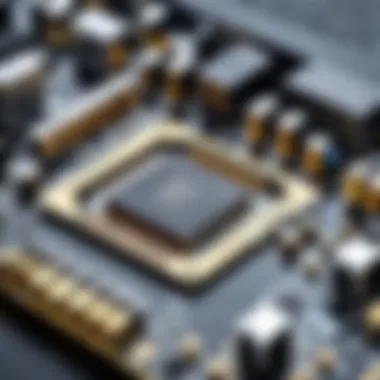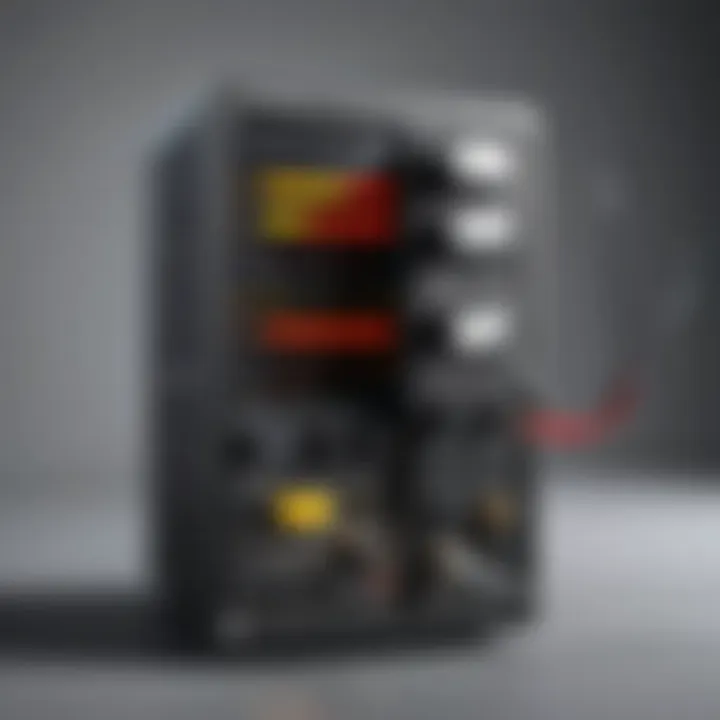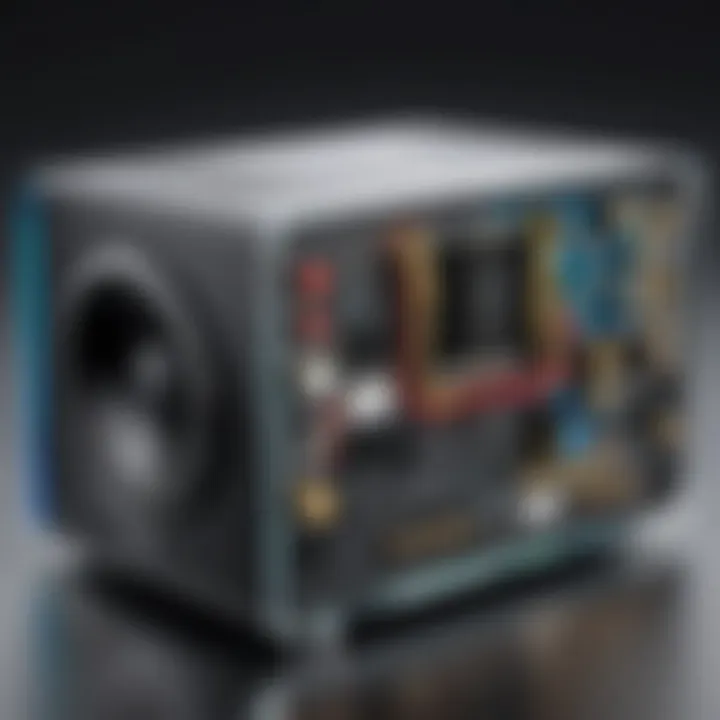Essential Guide to Troubleshooting Computer Audio Issues


Intro
In today's digital landscape, audio issues can hinder the user experience and disrupt workflows. Whether it’s for work or leisure, seamless sound is vital for effective communication and interaction with multimedia content. This guide offers practical strategies for diagnosing and resolving common audio problems on computers, making it an invaluable resource for IT professionals and tech enthusiasts alike.
The complexity of audio systems in computers can often lead to confusion. Differentiating between hardware malfunctions and software misconfigurations can be daunting. However, this guide breaks down the troubleshooting process into manageable steps, enhancing your ability to diagnose issues confidently.
Overview of Audio Hardware/Software
Understanding the critical components of audio systems is essential. Both hardware and software play significant roles in overall audio performance.
Audio Hardware
Key Components
- Sound Card: This integral hardware component processes audio data. The quality of a sound card can greatly influence auditory output.
- Speakers or Headphones: Output devices directly affect how sound is heard. Issues here may lead to misinformation about system faults.
- Cables and Connectors: Ordinary but essential; damage here can lead to signal loss or degraded audio quality. Regular inspection often helps avoid frustration.
Setup Essentials
For the best setup, peripherals should be appropriately connected. Understanding port types (USB, 3.5mm) is essential for interaction between devices. You should also ensure that drivers for any external hardware are current, which often resolves linked audio problems.
Audio Software
Essential Features
Audio software encompasses not just drivers, but also operating systems settings and additional applications such as sound enhancement software.
Operating System Impact
From Windows to macOS, system updates can accidentally overwrite important audio settings. Familiarity with built-in audio troubleshooting tools can quickly guide users to solutions.
Common Troubleshooting Steps
While the complexity of audio systems can be intimidating, adopting a systematic approach helps simplify the issue.
Initial Checks
- Ensure volumes are active and not muted.
- Check if output devices are selected correctly in audio settings.
Restart
Simply restarting the computer might resolve many small issues, including sound and driver issues that can go awry after prolonged use.
Advanced Diagnostics
- Driver Updates: Use the device manager to update audio drivers frequently.
- Settings Evaluation: Change sound settings back and forth, which has been known to reset problematic configurations.
- Audio Troubleshooter (Windows): This built-in feature often helps identify problems automatically.
Preamble to Audio Issues
Audio issues in computers can significantly hinder user experience. In a world where communication, entertainment, and work all rely heavily on sound, addressing audio concerns becomes essential for every user. This section introduces key elements that will be explored further in the article and emphasizes the importance of understanding noise disturbances and limitations in output.
Sound breakthroughs in computer applications are reliant on multiple components, both hardware and software. Grasping the interplay between these elements helps in identifying roots of sound problems. Users, whether mastery in IT or novice tech enthusiasts, face common anomalies ranging from symptoms like distorted sound or absent audio. Discovering the underlining causes of these frustrations and remedies builds knowledgeable confidence for users.
Properly diagnosing these issues is not only beneficial for immediate fixes but also for longer term durability of a computer's audio capabilities. This understanding fosters capacity to allow devices to meet their full potential while delivering satisfactory audio experience. Furthermore, awareness of the complexities associated with sound often leads to better preventive choices regarding audio equipment and software management.
Establishing a foundational knowledge on audio issues includes recognizing typical problems that manifest frequently. Addressing these initial barriers helps users approach matters systematically, avoiding frustration and mishaps in their troubleshooting approach.
In this guide, we will disect each element ot understanding audio chaos. From unmentioned peanuts in audio connections to deep dive troubleshooting techniques suited for all operating systems, the discussion will enlighten our readers about not just solutions but underlying auditory principles that affect performance.
"A well-functioning audio system becomes an extension of a person's reality. Investing time in understanding it goes a long way."
Enlightened readers who grasp audio technologies and troubleshoot pragmatically will enhance their competency while driving effective actions to combat any future audio woes.
Understanding Audio Components
Understanding audio components is crucial for effectively troubleshooting audio problems associated with computers. Different components widely contribute to the quality and functionality of sound output. Identifying and comprehending these can streamline the diagnosis and resolution process for tech enthusiasts and IT professionals alike. Recognizing hardware configurations and software implications fosters confidence and familiarity in dealing with audio-related challenges.
Hardware versus Software Issues
When troubleshooting audio, one must distinguish between hardware and software issues. Hardware issues refer to problems with physical components like speakers, sound cards, and headphones. Software issues often stem from settings or conflicts within the operating system or applications. A fundamental understanding of the distinction makes it easier to methodically approach each issue, ensuring the best possible fix.


Common Hardware Components Involved
Speakers
The speakers are central to sound reproduction in any computer system. Their primary role is to convert electrical signals into audible sound waves. An important characteristic to consider is the quality of sound they produce; this quality can vary significantly across different models. This article emphasizes well-designed speakers like the Logitech Z623, which boasts high power output and clarity. These speakers often provide accurate sound and reduce distortions, leading to a better user experience. A downside might be their dependence on space for optimal positioning but overall, their capabilities make them a popular choice among users who seek rich audio experience.
Sound Cards
A sound card plays an essential role in managing audio signals in computers. It converts digital audio signals from software into analog signals for playback through speakers or headphones. The famous Creative Sound Blaster range exemplifies sound cards that enhance audio quality consequentially, especially for gaming and music applications. They stand out for their support of multiple audio channels and advanced audio processing technologies, adding richer layers to the audio output. The primary downside, however, is the potential compatibility issues when outdated drivers exist, significantly affecting audio performance.
Headphones
Headphones are a critical component for personal audio listening, particularly in noisy environments or where speakers are impractical. They allow for intimate sound experiences while maintaining privacy. The balance of audio quality and comfort in models like the Bose QuietComfort 35 makes them a favored choice for both casual and professional users. Users frequently appreciate features such as noise cancellation. However, the dependency on sharing sources can make them less versatile than speakers in group settings.
A proper understanding of each audio component is vital for efficient troubleshooting.
Analyzing these hardware components with clear insight helps to recognize the roots of audio issues more swiftly. Keeping essential details about each element enables IT professionals and enthusiasts to obtain targeted solutions, ensuring an optimal audio experience.
Initial Checkpoints for Audio Issues
In troubleshooting audio issues on computers, the initial checkpoints serve as a foundational step. These checkpoints help in narrowing down the source of the problem efficiently. Often, symptoms displayed might mislead one to believe there is a complex issue, while the solution may stem from simple oversight. Thus, undertaking these initial steps streamlines the troubleshooting process.
Understanding sound settings implies verifying all variables which can impact audio performance. Skipping this stage might lead to unnecessary complications or prolonged downtime. For this reason, it becomes critical to engage with these early checkpoints with diligence.
Verifying Volume Settings
When facing audio issues, the first step should always involve confirming that the volume levels are appropriate. Often users may accidentally mute the audio or lower it too much. It can seem trivial, but deciphering sound issues stems from comprehensively checking this fundamental aspect.
- Ensure the system volume is not muted. This can usually be checked directly through system tray icons.
- Look at application-specific volume levels as they might override the system settings.
- Check for physical volume adjustments on speakers or monitors that might affect overall output.
Covering these basic checks eliminates one of the primary possible failures.
Inspecting Audio Devices
Once volume settings have been verified, the next imperative step is to inspect the audio devices themselves. This involves examining both output and input devices connected to the system, ensuring that they operate correctly and as intended.
Connections and Cables
The significance of the connections and cables cannot be overstated. Poor or damaged connections can alter how sound signals transmit. A fundamental characteristic to acknowledge is that connections must be secure and well-made for optimal audio performance. Whether it’s a USB cable carrying digital audio or a 3.5 mm headphone jack relaying analog signals, each must maintain connectivity to avoid disruption.
Key points related to Connections and Cables:
- Check for any visible damage on cables, including fraying or cracks.
- Ensure connectors are securely plugged into ports. Connection looseness can create intermittent audio issues.
- It is essential to use good-quality cables to ensure minimal loss of audio fidelity.
Device Recognition
The aspect of device recognition bridges hardware and software functionality. The system must correctly identify all audio hardware connected to it to function effectively. Device recognition is crucial in ensuring the operating system assigns them properly or implements them correctly.
- When plugging in an audio device, listen to the sound prompt from the system. It generally indicates a successful recognition.
- Open the system settings to see if the hardware listed aligns with the devices in use.
- If an audio device is not recognized, troubleshooting can be required through reinstallation of the driver or preliminary checks on connections.
Every stage and area addressed ensures fewer roadblocks along the way for problem resolution, catering specifically to common sound output concerns.
"Initial checkpoints simplify resolving audio issues by eliminating fundamental causes swiftly."
Driver Issues and Their Impact
Drivers are integral to the effective functioning of audio hardware in computers. They serve as the bridge between the operating system and the audio components, allowing for smooth interaction and functionality. When these drivers malfunction or are configured improperly, the ability to transmit sound effectively diminishes, resulting in a less-than-desirable experience. Understanding driver issues is essential because addressing them often resolves many audio disturbances that users frequently encounter. Without the right drivers, the audio output may become erratic or disappear entirely. This section elucidates how to identify driver problems and highlights the crucial steps for updating or reinstalling them.
Identifying Driver Problems
The first step in tackling driver-related audio issues is recognizing the signs of driver problems. Users may observe varied symptoms, including inconsistent audio quality, sudden dropouts, or complete absence of sound. These issues can stem from several factors: incorrect driver installation, outdated drivers, or driver corruption due to incomplete updates.
Common indicators that suggest driver issues include:
- No Audio Output: Despite the correct connections and functioning hardware, sound does not play.
- Frequent Crashes: The audio stream tends to stop abruptly or results in application crashes.
- Distorted Sound: Audio may be garbled or exhibit an echo.
- Device Not Recognized: Operating systems fail to identify audio devices.
Taking note of these signs is key in troubleshooting audio problems effectively. Monitoring your system for unusual behavior can reveal much about possible driver issues at play.
Updating or Reinstalling Drivers
Once the driver problems are identified, the next logical step is updating or reinstalling the appropriate drivers to bring functionality back to a correct level. Outdated drivers can be directly linked to numerous audio issues. Many contexts highlight a connection between newly installed software or system updates and older drivers. They often result in compatibility issues that affect audio components.


To update drivers:
- Go to the Device Manager by right-clicking the Start button.
- Expand the Sound, video and game controllers section.
- Identify your audio device, right-click, and select Update driver.
- Choose Search automatically for updated driver software.
The system will then search for relevant updates. If an update is available, it will be installed automatically. However, if updating does not resolve the concerns, reinstalling drivers may be the next strategic move.
To reinstall drivers:
- Follow the steps above to access Device Manager.
- Right-click the audio device and select Uninstall device.
- Restart your computer, prompting the system to reinstall the driver automatically.
Reinstalling can resolve problems created by incorrect configurations or damaged drivers. In many cases, this step can restore full functionality to audio devices.
Keep in mind: Always download the latest drivers directly from the manufacturer’s official website, as this guarantees the authenticity and integrity needed for optimal performance.
Software Configuration Troubles
Software configuration troubles can greatly impact audio performance on computers. Proper configuration in audio settings is essential for ensuring compatibility among various software applications and devices. This section focuses on specific aspects of software factors affecting audio output, benefits of setting adjustments, and considerations to keep in mind when configuring audio settings.
Audio Settings in Operating Systems
Each operating system has its unique setup for managing audio settings. In Windows, for example, users can access the audio configurations through the Control Panel or the Settings app. Here, you can manage output devices, volume levels, and playback settings. It is critical to select the correct audio device if multiple components are connected, such as Bluetooth speakers or headphones.
On Mac operating systems, audio settings are found in the Sound preferences menu. It allows users to adjust output and input options. Users can select the output device of choice and carry out test sounds to check if the configuration is correctly set.
The importance of keeping software up to date cannot be understated. Updates may include patches that improve audio functionality or compatibility with various hardware configurations. Outdated settings can lead to a host of audio issues, such as distorted sound or latency. Familiarity with accessing and adjusting audio settings is fundamental for swift resolutions of troubles when they arise.
Impact of Third-party Applications
Third-party applications can significantly influence audio quality and output. Some programs may succeed in creating complicated audio configurations that need direct user intervention to rectify misunderstandings. For example, media players often have their own equalizers and audio routing settings that can conflict with system settings. This raises the importance of verifying application-specific audio settings.
Furthermore, many communication or projection applications may try to claim audio control during use. This could inadvertently mute other system sounds. Being attentive to the interference from these applications can minimize disruptions in audio performance.
Key steps include:
- Identifying Workflow: Acknowledge which applications utilize sound each time they are used.
- Configuring Application Settings: Adjust the preferences in each app to specify which audio device it is using.
- Monitoring Background Processes: Some applications silently take control over system audio. Conducting periodical checks can reduce hindrances.
The interaction between apps and system audio settings may seem seamless, yet, discrepancies can lead to silent frustrations. Awareness of these issues empowers users to troubleshoot effectively and maintain smooth audio experiences.
System-Specific Audio Troubles
Audio issues can differ markedly between systems. Understanding these variations helps diagnose and solve problems efficiently. Knowledge of system-specific audio troubles fosters a comprehensive grasp of user experience, focusing intervention strategies effectively. Users may realize that solutions for Windows might not easily translate to macOS, highlighting the necessity of targeted approaches.
Windows Operating System
Troubleshooting using Windows Settings
Utilizing Windows settings for troubleshooting is crucial. The system offers a unique framework for checking audio configurations. This approach allows examination of sound systems, adjustments of output devices, and sound formats. Users can adjust volume levels for each application, solving issues related to certain applications not producing sound.
A notable characteristic of using Windows settings is their intuitive layout. It is user-friendly, which is a beneficial choice for many users encountering audio troubles. Windows settings simplify navigation, ensuring quick access to necessary configurations.
Despite its advantages, one potential disadvantage can be overwriting user configurations unintentionally. The direct manipulation of settings may lead to new issues if not managed carefully.
Using Windows Troubleshooter
The Windows Troubleshooter is a powerful tool. It automates several checks to identify audio-related problems. This feature allows users to run diagnostics without manual intervention, streamlining the troubleshooting process efficiently.
A key characteristic of the Windows Troubleshooter is its ability to suggest fixes based on collected system information. Utilizing this tool offers a well-defined check-list for common audio issues. As a result, combining it with Windows settings leads to comprehensive problem solving.
One unique aspect is it can resolve minor conflicts quickly and autonomously. However, if the underlying issue is complex, larger diagnostic tools may be required for proper examination.
Mac Operating System
Sound Preferences Adjustments
Adjusting sound preferences is paramount on macOS. This aspect allows users to control volume levels, input/output sources, and microphone settings. Accessing sound preferences can lead to changes that tackle echo or sound imbalance.
The critical feature of these adjustments lies in streamlined accessibility. They enable a selection of audio devices with clarity and responsiveness. Thus, adjustments become a key focus for anyone trying to solve audio outputs on Mac.
Nevertheless, making incorrect adjustments can ironically lead to heightened issues. Users should be careful and ensure that they reset to desired values after testing various configurations.
Resetting Core Audio


Resetting Core Audio is quite distinguishable. As a built-in audio management system, it oversees all audio aspects in macOS. Whenever audio fails unexpectedly, resetting this component can resolve significant troubles quickly.
This specific procedure promises repairs. It automatically optimizes settings reverting them to a stable state. It streamlines the system on startup.
However, one should proceed with caution. Resetting Core Audio may disrupt custom settings. Users might need to revisit preferences post-reset to tailor their system sound to their specifications.
External Factors Affecting Audio Performance
Audio issues on computers can often stem from complicated root causes. Understanding how external factors can influence audio performance is crucial for effective troubleshooting. These factors may include interference from other devices and the impact of system updates. Both can lead to unexpected disruptions or deterioration in sound quality. Analyzing these elements helps professionals pinpoint sources of problems more accurately, allowing for targeted interventions rather than attempting a broad remedy that may not address the fundamental issue.
Interference from Other Devices
Interference from other devices is a frequent culprit involved in poor audio performance. Common sources of interference include routers, microwaves, and even plugged-in USB devices. These devices can emit electromagnetic fields that may affect the audio signals being processed by the computer. The influence may lead to buzzing sounds, drops in sound quality, or complete audio silence.
To minimize such interference, one can take several steps:
- Distance: Physically separating audio equipment and sound sources from potential interference sources.
- Quality Cables: Using shielded cables for all audio connections helps protect against unwanted interference.
- USB Ports: Utilizing ports on opposite sides of a laptop may reduce interference from specific components within the machine.
In some cases, deploying ferrite beads on cables may help by filtering high-frequency noise. Recognizing the devices that can cause audio disruptions allows for more informative strategies to maintain sound quality.
Impact of System Updates
System updates, necessary as they may be, can sometimes disrupt audio performance. Updates frequently come with new drivers, security patches, or software changes that inadvertently alter sound settings or operational frameworks of audio drivers. This phenomenon can lead to various issues ranging from complete sound loss to inconsistency in volume levels.
Here are some considerations regarding system updates:
- Assessment After Update: Always reassess audio settings immediately after applying updates to catch any negative changes.
- Reverting Changes: Have procedures in place for reverting back to a previous system version if an update proves problematic for audio performance.
- Awareness of Known Issues: Follow specific forums or Reddit discussions to stay informed about known audio issues arising from updates in systems like Windows or Mac.-
It's advisable to create a backup of audio settings, if possible, before implementing system updates so reverting can be quick and simple. Taking a proactive stance on system updates ensures a seamless audio experience without constantly facing interruptions.
Understanding external factors is vital for effective audio troubleshooting. One key misstep is to overlook the potential impact other devices and software changes can have on audio functionality.
By categorizing these influences and employing systematic troubleshooting approaches, IT professionals and tech enthusiasts can address audio problems confidently and efficiently.
Advanced Troubleshooting Techniques
Advanced troubleshooting techniques are crucial when the standard methods fail to resolve audio issues. This section aims to equip IT professionals and tech enthousiasts with in-depth strategies that go beyond the basics, delving into tools and logs that can reveal hidden problems. Learning these techniques not only enhances one’s diagnostic skills but also improves overall efficiency in dealing with complex setups.
These elevated measures allow users to locate intricate issues associated with audio output. Using effective diagnostic tools can save significant time by pinpointing problems quickly rather than relying solely on trial and error. Furthermore, checking system logs provides insights that help trace the origins of the malfunction, allowing for a targeted approach in resolving the audio issues. Maintaining awareness of such methodologies becomes valuable as technology continues to evolve.
Using Diagnostic Tools
Employing diagnostic tools can streamline the troubleshooting process. Tools are often designed to identify specific problems that manual checking might overlook. Software such as Windows Sound troubleshooter or Mac's Audio MIDI Setup play pivotal roles. They allow users to run systematic checks that generate reports about existing audio device configurations and possible conflicts.
Here are several tools that can assist in this process:
- Windows Device Manager: Use this to examine audio drivers. It indicates any issues or conflicts that may affect audio performance.
- LatencyMon: This analyzes system performance and identifies driver latencies that can disrupt audio playback.
- DPC Latency Checker: By monitoring how efficiently a system can handle real-time audio tasks, this tool helps ascertain if hardware can manage audio tasks adequately.
Utilizing these tools provides concrete data that can influence the decision-making process. Moreover, it can also minimize the need for returning hardware which often is the case with guesswork. Ultimately, incorporating diagnostic tools reflects a well-organized approach to troubleshooting audio concerns.
Checking System Logs
Another indispensable strategy in advanced troubleshooting involves tapping into system logs. Both Windows and Mac operating systems maintain logs that account for activity, including errors with audio performance.
Windows Event Viewer
In Windows, the Event Viewer is a valuable asset. It catalogues significant occurring events which could lead to insight on current issues. Users can navigate to the 'Windows Logs' -> 'System.' Here they can filter through to find audio-related errors.
macOS Console
For Mac users, using the Console app allows one to dive into a collection of system log reports. Users can look specifically for 'audio' keywords or examine if there are specifics about failed device interactions.
"System logs can unveil both historical issues and recurrent errors impacting your audio experience. Tools that dive deep into these logs are critical for advanced troubleshooting."
Reviewing logs not only points towards recurring audio malfunctions but may also reveal necessary system updates or driver reinstalls without needing to perform intensive tests. A thorough check of system logs often proves rewarding in determining the underlying issues affecting sound operations.
Equipped with these advanced techniques, professionals can develop a methodical approach to tackle complex audio problems, leading to more efficient and effective resolutions.
The End
Emphasizing a systematic approach can lead to successful resolutions of issues that may otherwise seem daunting. Here are some key considerations:
- Importance of Knowing Components: Understanding both hardware and software components facilitates a more effective troubleshooting process.
- Diagnostic Tools: Utilizing relevant diagnostic tools simplifies the detection of underlying issues efficiently. The right tools can save time and prevent unnecessary rescues.
- User Empowerment: Encouraging users with clear guidelines serves to enhance their confidence in managing their own audio-related dilemmas.
To recap, being well-versed in audio trouble basics can not only quickly rectify common issues but also assist in avoiding more complex problems down the line.
Finally, continuous learning and adapting to new software updates and hardware changes are vital. This ensures robust solutions to audio problems. Keeping abreast of developments can greatly prepare users, preventing frustration and ensuring a seamless auditory experience during computing.



